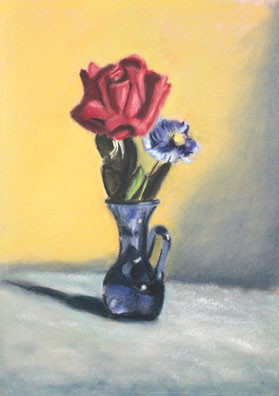Rose in Blue Glass Vase

Again a pastel rendering of a glass vase mit flowers.
One is, as we said above, a rose. The other is some kind of a blue-purple flower. Not quite sure what kind.
Drawing glass can be a bit of a challenge - or at least daunting if you haven't done it before. After all a lot of things reflect in the glass which can confound the eye. The often curved surfaces create distortions, and the reflections change even if you shift your head a little or the light alters. Sure, the light will always change a little unless you're in windowless room, but with a good spotlight it won't be that much.
Of course the way to handle the changing reflections is 1) make sure you can always view the vase from the same place and 2) make sure the light will be constant. That last bit is easily handled by directing a strong lamp from a given direction.
But as far as drawing the vase itself, the main thing is to look at the object in terms of it being shapes of color and how the shapes relate to each other. A useful technique is to squint. When you squint more subtle shapes will merge together producing just a few of the basic forms. You draw those shapes first. Then you squint less and you see more of the shapes. Keep squinting less and less and eventually you can add as much detail as you like.
Drawing a colorless vase - where there are a larger number of colors in the reflections - is a bit more difficult that drawing a colored vase - particularly a dark colored vase as here. But the principles are the same.